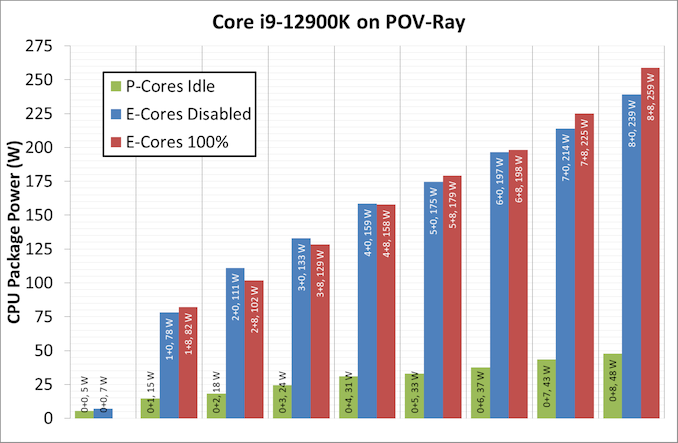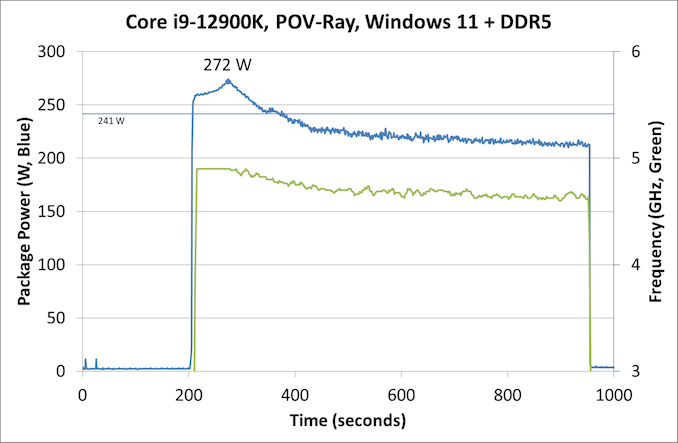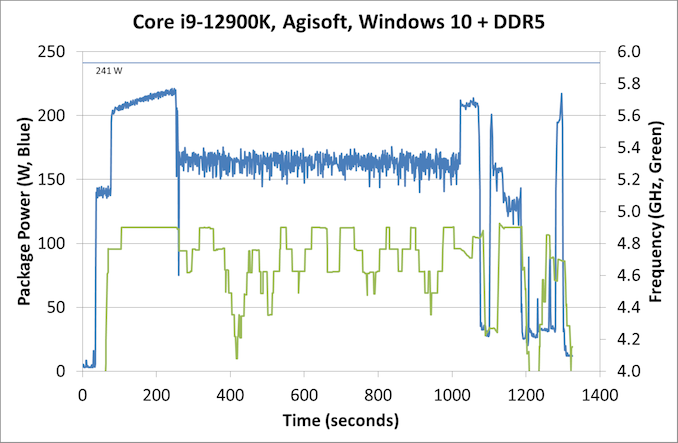The Intel 12th Gen Core i9-12900K Review: Hybrid Performance Brings Hybrid Complexity
by Dr. Ian Cutress & Andrei Frumusanu on November 4, 2021 9:00 AM ESTPower: P-Core vs E-Core, Win10 vs Win11
For Alder Lake, Intel brings two new things into the mix when we start talking about power.
First is what we’ve already talked about, the new P-core and E-core, each with different levels of performance per watt and targeted at different sorts of workloads. While the P-cores are expected to mimic previous generations of Intel processors, the E-cores should offer an interesting look into how low power operation might work on these systems and in future mobile systems.
The second element is how Intel is describing power. Rather than simply quote a ‘TDP’, or Thermal Design Power, Intel has decided (with much rejoicing) to start putting two numbers next to each processor, one for the base processor power and one for maximum turbo processor power, which we’ll call Base and Turbo. The idea is that the Base power mimics the TDP value we had before – it’s the power at which the all-core base frequency is guaranteed to. The Turbo power indicates the highest power level that should be observed in normal power virus (usually defined as something causing 90-95% of the CPU to continually switch) situation. There is usually a weighted time factor that limits how long a processor can remain in its Turbo state for slowly reeling back, but for the K processors Intel has made that time factor effectively infinite – with the right cooling, these processors should be able to use their Turbo power all day, all week, and all year.
So with that in mind, let’s start simply looking at the individual P-cores and E-cores.
Listed in red, in this test, all 8P+8E cores fully loaded (on DDR5), we get a CPU package power of 259 W. The progression from idle to load is steady, although there is a big jump from idle to single core. When one core is loaded, we go from 7 W to 78 W, which is a big 71 W jump. Because this is package power (the output for core power had some issues), this does include firing up the ring, the L3 cache, and the DRAM controller, but even if that makes 20% of the difference, we’re still looking at ~55-60 W enabled for a single core. By comparison, for our single thread SPEC power testing on Linux, we see a more modest 25-30W per core, which we put down to POV-Ray’s instruction density.
By contrast, in green, the E-cores only jump from 5 W to 15 W when a single core is active, and that is the same number as we see on SPEC power testing. Using all the E-cores, at 3.9 GHz, brings the package power up to 48 W total.
It is worth noting that there are differences between the blue bars (P-cores only) and the red bars (all cores, with E-cores loaded all the time), and that sometimes the blue bar consumes more power than the red bar. Our blue bar tests were done with E-cores disabled in the BIOS, which means that there might be more leeway in balancing a workload across a smaller number of cores, allowing for higher power. However as everything ramps up, the advantage swings the other way it seems. It’s a bit odd to see this behavior.
Moving on to individual testing, and here’s a look at a power trace of POV-Ray in Windows 11:
Here we’re seeing a higher spike in power, up to 272 W now, with the system at 4.9 GHz all-core. Interestingly enough, we see a decrease of power through the 241 W Turbo Power limit, and it settles around 225 W, with the reported frequency actually dropping to between 4.7-4.8 GHz instead. Technically this all-core is meant to take into account some of the E-cores, so this might be a case of the workload distributing itself and finding the best performance/power point when it comes to instruction mix, cache mix, and IO requirements. However, it takes a good 3-5 minutes to get there, if that’s the case.
Intrigued by this, I looked at how some of our other tests did between different operating systems. Enter Agisoft:
Between Windows 10 and Windows 11, the traces look near identical. The actual run time was 5 seconds faster on Windows 11 out of 20 minutes, so 0.4% faster, which we would consider run-to-run variation. The peaks and spikes look barely higher in Windows 11, and the frequency trace in Windows 11 looks a little more consistent, but overall they’re practically the same.
For our usual power graphs, we get something like this, and we’ll also add in the AVX-512 numbers from that page:

Compared to Intel’s previous 11th Generation Processor, the Alder Lake Core i9 uses more power during AVX2, but is actually lower in AVX-512. The difficulty of presenting this graph in the future is based on those E-cores; they're more efficient, and as you’ll see in the results later. Even on AVX-512, Alder Lake pulls out a performance lead using 50 W fewer than 11th Gen.
When we compare it to AMD however, with that 142 W PPT limit that AMD has, Intel is often trailing at a 20-70 W deficit when we’re looking at full load efficiency. That being said, Intel is likely going to argue that in mixed workloads, such as two software programs running where something is on the E-cores, it wants to be the more efficient design.














474 Comments
View All Comments
web2dot0 - Thursday, November 4, 2021 - link
Who in their right mind thinks Intel is moving in the right direction?250W TDP?!?!?
Apple came out with their 30W TDP that can rival desktop CPU parts.
Comically embarrassing.
geoxile - Thursday, November 4, 2021 - link
Apple rivals desktop CPUs in SPECINT, which clearly loves memory bandwidth and cache. DDR5 alone boosted ADL's score in SPECINT MT by 33% from a DDR4 configuration. In Cinebench and geekbench the m1 pro and max are closer to workstation laptop processors. We'll see what happens with ADL mobile.Ppietra - Thursday, November 4, 2021 - link
The 12600K has basically the same Geekbench score of the M1 Max, and yet its 10 cores consume 3 times more than the M1.On the 12900K just using the 8 E-cores consumes more than the M1 Max using the CPU at peak power. So we shouldn’t expect big miracles in mobile, unless Intel starts selling 90W chips.
As for Cinebench, it will be difficult for Apple Silicon to come out on top until Apple implements some sort of Hyperthreading, Cinebench takes good advantage from it.
geoxile - Thursday, November 4, 2021 - link
The H55 segment will offer 8+8 at 45W and H45 will offer 6+8 at 35W, no need to compare the 12600k. We have models for how mobile uses power compared to desktop. They retain 80-90% of the performance at 1/3 to 1/4 the sustained power. 5900HS @ 35W cTDP (35-40W actual power) has around 85% the performance of the 5800X @110-120W in cinebench. The 11980HK at 45W has almost 90% the performance of the 11700k at 130-150W (non-AVX) in geekbench 5.Ppietra - Thursday, November 4, 2021 - link
Closer to 15% drop in Geekbench, and probably at much higher package peak power draw than 45W, considering what Anandtech has measured for the 11980HK in Multithreaded tasks (around 75W).geoxile - Thursday, November 4, 2021 - link
The 11980HK respects the configured PL/cTDP for the most part. It only hits 75W during the initial cold start. It uses 65W sustained power when configured to PL 65 and 45W when configured to 45Whttps://www.anandtech.com/show/16680/tiger-lake-h-...
I screwed up using tom's results for geekbench, apparently it is at PL 65 unlike Anand's for the TGL test system. But it also scores 9254 vs anandtech's 11700k scoring 9853, so within around 94% performance of its desktop counterpart. I've seen some higher scores on GB itself but using "official" sources that's pretty close to 2x more efficient. I can't seem to find any real PL 45 results for GB5. Point is, scaling down isn't a problem, and ADL will no doubt scale down better thanks to E-cores and just overall better efficiency based on what we've already seen, like gaming efficiency according to igorslab and PL 150 making barely any difference in performance compared to PL 220. I think Intel is in a unique position since AMD doesn't have small cores anymore.
Ppietra - Friday, November 5, 2021 - link
What you are failing to realize is that Geekbench, due to its short tests nature, ends up spending a lot of time at peak performance and not at sustained performance.And no, the 11700k doesn’t score 9853 - you are looking at averages on the Geekbench site which are not reliable to make this sort of comparison. Notebookcheck geekbench score is close to 11300, while the 11980HK scores closer to 9700.
geoxile - Friday, November 5, 2021 - link
Geekbench runs for a few minutes afaik. The peak you're describing only lasts for a split second and quickly falls down to the sustained power over a few seconds to 30 seconds. And no, I'm not looking at averages from geekbench, I literally told you I'm using anand's score for the 11700k and tom's score for TGL mobile. https://www.anandtech.com/bench/CPU-2020/2972Ppietra - Friday, November 5, 2021 - link
geoxile, Geekbench is a bunch of discreet tests with pauses in between.The value that you used is almost exactly the average in the Geekbench database, and we know that the 11700 gets much higher than that. You can also check that Anandtech never showed Geekbench results with that CPU in any of its reviews of the 11700. Don’t know why that value is there.
geoxile - Friday, November 5, 2021 - link
Describing a context switch to load the next bench as "pauses" is borderline gaslighting. It's a memory workload, not idling. PL2 on the 11980HK lasts for seconds from cold start at PL1 45.It's almost or it's exact. Anandtech lists those scores and I have no reason to doubt they copied them or made them up. Tom's has slightly higher scores at 10253 @ stock. That's a 4% variance, probably due to tom's using DDR4 3600 with tuned timings while anandtech used DDR4 3200. It's only with a 5Ghz OC toms can even break through 11000, let alone score 11300.
https://www.tomshardware.com/reviews/intel-core-i7...